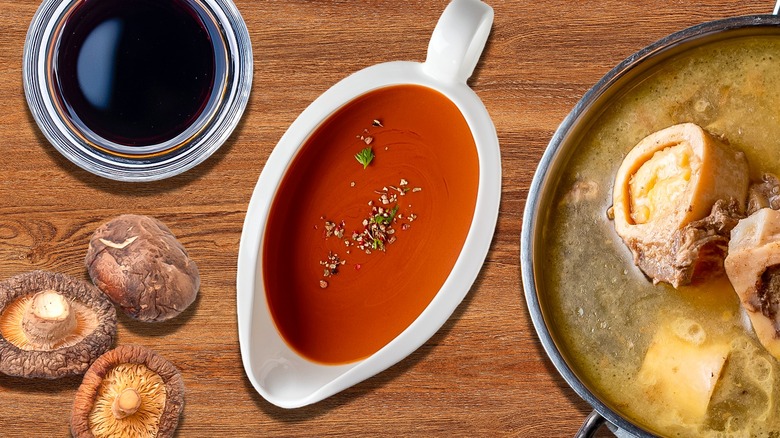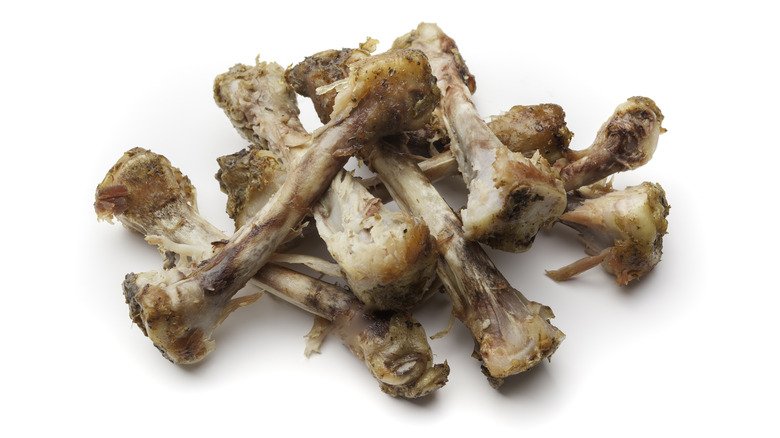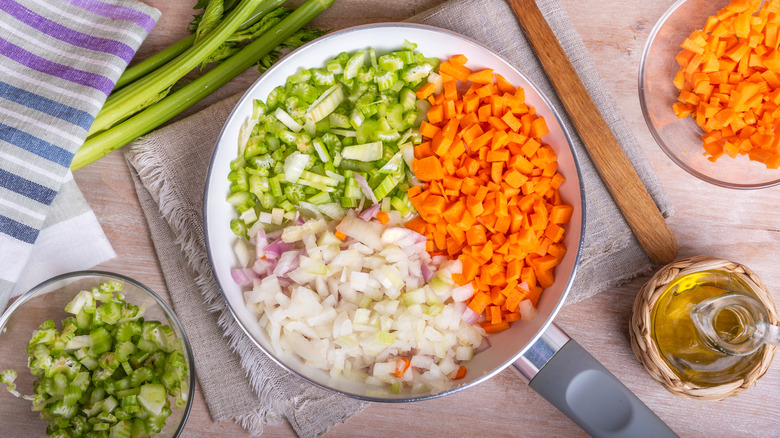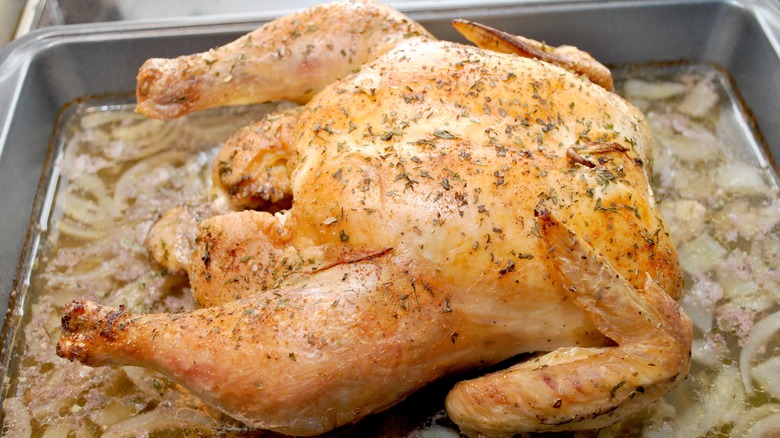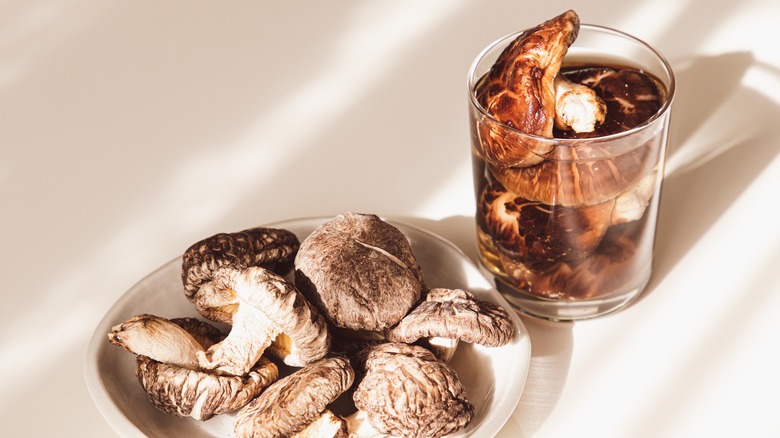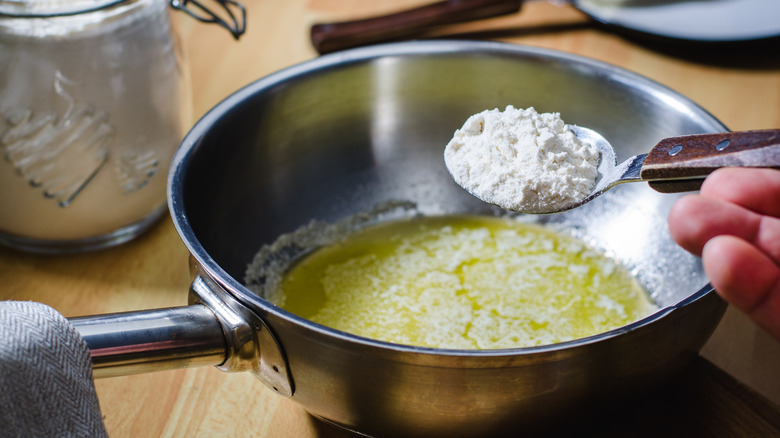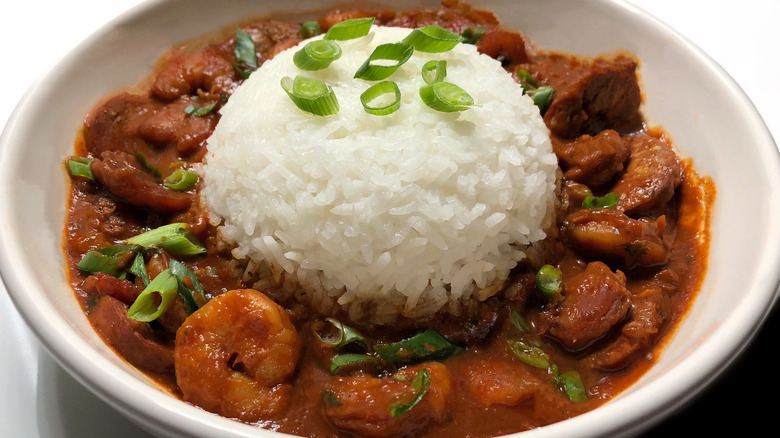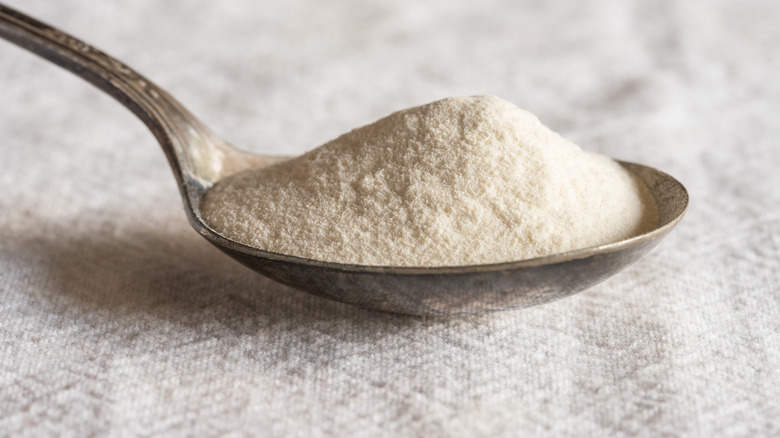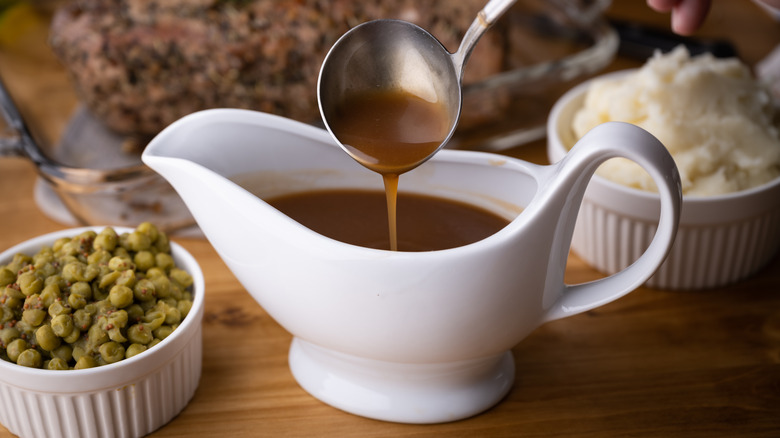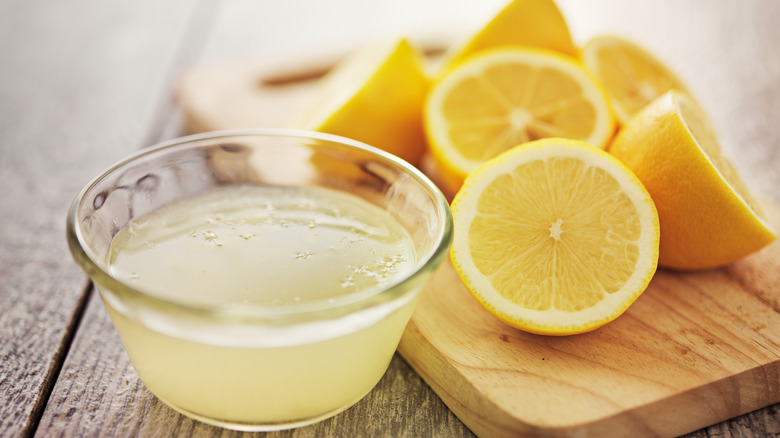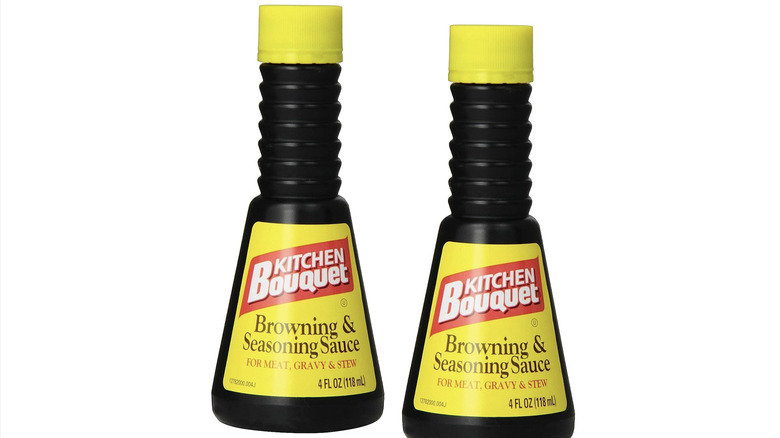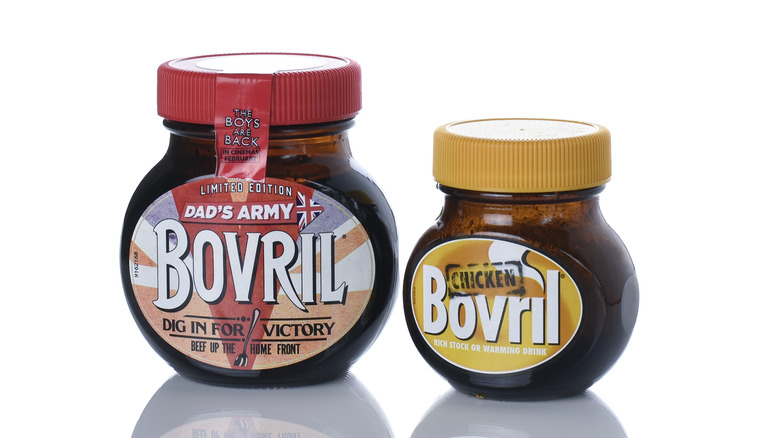11 Tips You Need When Making Brown Gravy
When you make gravy for holiday gatherings, does it fail to live up to the smooth and beautiful sauce of your dreams? Is its flavor limp, or is its color sad? Perhaps you're too intimidated to try making gravy from scratch and have been making do with the powdered or jarred stuff your whole life. Whatever your difficulties might be, this list aims to give you tips to make a perfect gravy every time. Our focus is on brown gravy — that is, gravy made with a stock or broth base rather than milk-based white gravy. Even so, many of these tips are transferable to white gravy if that's what you prefer.
Most of this list is based on my personal experience — I worked in restaurant kitchens for five years, and over that time, I honed my gravy technique to a "T." When you have to make enough gravy to feed hundreds of people at once, you get good at it in a hurry — and I'm happy to share my hard-won sauce knowledge. Anyone can make great gravy, and here's how.
1. Roasting the bones for your stock is key
Brown gravy is basically just thickened stock or broth, so if you don't start with flavorful stock the finished sauce can end up tasting a bit limp. You can use boxed broth from the grocery store, but if you have the time homemade stock will give you much better results. And if you're already putting in the effort to make your own broth by boiling bones, you might as well make it maximally delicious by roasting the bones first.
Roasting the bones will impart extra flavor because of the Maillard reaction — they'll become intensely savory and develop a caramelized, browned, toasty taste. Not only will this enhance the flavor of the broth, but it will improve its color too. We eat with our eyes first, and while a pale gravy may taste as good as a dark one, a deep brown sauce just looks tastier than a blonde one. Darkly roasting your bones will give the stock the rich color you're aiming for. You want the bones to be deeply browned but not charred — any blackened bits will impart an unpleasant bitterness to the finished product.
You can enhance browning by squirting some tomato paste on the bones before they go into the oven — the sugar in the paste will help with caramelization, and tomatoes contain natural umami-boosting compounds.
2. Mirepoix will level up your stock
A homemade stock made with only bones and meat will taste fine, but if you want real depth of flavor in your gravy, adding mirepoix is the way to go. This classic French trio of onion, carrot, and celery will contribute sweetness, brightness, and earthy vegetal flavors to your sauce — gravy that just tastes like pure meat will feel one-note by comparison. And there's no need to stop with just mirepoix; I like to add peppercorns, garlic, bay leaves, leek tops, and thyme sprigs as well. Whatever aromatics you like are fair game to throw in. Just be careful not to overdo it with the herbs, as too many can turn your stock green, which makes the gravy look more than a bit strange.
The aromatics can either be added to the pot raw and then boiled alongside the bones, or roasted before boiling. Raw aromatics will give your broth a fresher flavor, while roasted ones double down on Maillard savoriness. Alternatively, if you're preparing a large cut of meat to serve with your gravy (like a Thanksgiving turkey), you can put the aromatics under the meat as it roasts. This way, they'll flavor the pan drippings you'll later use as the base of the gravy.
3. If you're serving it with a roast, don't forget to include the drippings
Many of us make gravy primarily for big holiday dinners. In that case, there's probably a large hunk of meat being cooked in the oven, whether it's a turkey, ham, or prime rib roast. Whatever it is, as it's cooking, the meat will release juices (known as drippings) into the pan, and these drippings are basically liquid gold. They contain the concentrated flavor of the meat, and they'll make your gravy infinitely more delicious.
Depending on how long the meat has been roasted and at what temperature, the drippings may still be liquid by the time the meat is done, or they might have hardened into a browned crust (in fancy French terms, a fond). If they're liquid, drain them from the pan, de-fat them (either with a fat separator or by waiting for the oil to rise to the top and skimming it off), and mix them with your gravy. If the drippings have hardened, you'll have to deglaze them from the bottom of your roasting pan using some kind of hot liquid (stock is a good choice), scraping them up until they dissolve. Then they can be added to the sauce.
4. Dried mushrooms make for a great plant-based alternative
The tips so far have been very meat-centric, but vegetarians and vegans can make delicious brown gravy, too. Vegetable stock is one way to go, but for my money, it tends to be too sweet to mimic a traditional meat gravy — we expect gravy to be umami-forward, with perhaps a complementary note of sweetness. That's why mushroom broth is ideal for plant-based gravy. Mushrooms pack a ton of umami and very little sweetness; they have a flavor that can fairly be described as "meaty."
It's possible to make broth using fresh mushrooms, but dried mushrooms are better — unlike many dried foods, they're actually more flavorful than their fresh counterparts. To make a rich and delicious mushroom broth, soak your dried 'shroom of choice in hot water and wait until the flavor and color have been extracted into the liquid. Alternatively, you can simmer the 'shrooms with mirepoix, just like you would with bones. An even quicker hack is to dissolve porcini mushroom powder in hot water, though the resulting texture won't be as nice.
Once you've achieved a flavorful mushroom broth, simply thicken it to make vegan gravy. Substitute the butter in a traditional roux with your plant-based butter of choice, or use a non-roux thickener like starches or chemical thickeners.
5. Hot roux, cold stock, no lumps
The classic way to make gravy is to prepare a roux by cooking together fat (usually butter) and flour, then adding stock and/or pan drippings. The problem with this is that if you don't properly combine the roux with the liquid, the roux will cook into little clumps, and you'll be left with a chunky mess instead of a smooth sauce. The first step towards ensuring a smooth gravy is to cook the roux long enough — even a blonde roux should smell like cooked flour before adding liquid. The second and most important step is adding the liquid the right way.
There are two routes here. One is to start incorporating the liquid very slowly (we're talking a few drops at a time at first), whisking constantly until each addition is completely incorporated. As the roux thins out, you'll be able to add more and more stock each time until your preferred gravy texture is achieved. This method is safe, but it's slow and needs constant attention. The other method requires some bravery but is fast and relatively foolproof. When your roux is hot and ready, dump in chilled stock all at once. The cold stock will lower the temperature of the pan dramatically, giving you enough time to whisk together the roux and stock before the roux can start cooking and forming lumps. Keep stirring until the gravy comes back to a simmer, and you're good to go.
6. A dark roux can add a new dimension of flavor
Brown gravy is often made with a blonde roux — not a white one like you'd use for bechamel or cream sauce, but one that's still relatively pale and hasn't been cooked for a long time. This type of roux is primarily used as a thickener rather than a flavoring agent; it will add a mild note of toasted flour to your gravy (as well as some buttery flavor if that's the fat you used to make it), but those subtle tastes will be mostly overshadowed by the flavorful broth and drippings.
If you experiment with the color of your roux, it can make your gravy taste completely different. Dark roux, which is commonly associated with Cajun and Creole cuisine, is cooked until the flour is very deeply toasted and brown, sometimes even verging on black. This type of roux can add a roasted, smoky, almost chocolatey, pleasantly bitter taste to your gravy. If you go this route, swap the butter in the roux out for fat with a higher smoke point (butter will burn if you try to make a dark roux with it). Also, be mindful that dark roux has less thickening power than blonde or white; you'll need to add more to your stock to make it thick enough to coat food.
7. Experiment with alternative thickeners
Roux is a classic and delicious way to thicken gravy, but it's by no means the only one. Probably the easiest way to transform broth into gravy is by using some kind of pure starch — corn starch is the easiest one to find in American grocery stores, but potato starch, sweet potato starch, and arrowroot starch (also called arrowroot powder or flour) all work too. Simply mix the starch with some cold liquid first so it doesn't clump up, then stream the starch slurry into the hot broth, stirring constantly. One advantage of starch is that it thickens almost instantly. There's no need to cook out any raw flour flavor; once the stock and starch mixture comes to a boil, it will be fully thickened, and the starch is almost flavorless. However, some people dislike the gelatinous texture of starch-thickened sauces.
Another option is to adopt a touch of molecular gastronomy and use chemical thickeners like xanthan gum or Ultratex. Like starch, these ingredients have a neutral flavor, and you may prefer the texture they give to the sauce. Pure starch and chemical thickeners are safe for gluten-free eaters, too, which is a plus.
8. Remember that your gravy will continue to thicken as it cools
Whether you choose to make a roux or use something like cornstarch to thicken your gravy, you'll want to remove it from the stove when it looks slightly thinner than you want. That's because starch, whether in pure form or contained inside an ingredient like flour, is a temperature-dependent thickener — once it's been cooked into a sauce, its thickening power will increase as the sauce cools down. What looked like a perfect gravy on the stove can turn into a gloopy mess after 10 minutes of sitting in a gravy boat. That's not ideal — aspics have been out of style for decades, and most people don't want to eat food covered in meat-flavored jelly.
You have to be particularly careful not to over-thicken cornstarch-based sauces, as pure starch gives foods a particularly unpleasant gelatin-like texture when overused. If you do realize that your gravy has set up into a solid block halfway through dinner, it's not the end of the world. Just scrape it back into a pot with a little extra broth or water and heat it up until it returns to liquid form.
9. A little acidity can liven up the flavor
Brown gravy lives and dies on the strength of its savory, meaty flavor, but contrasting elements can be used in moderation to make it taste even better. If you find that your gravy seems a bit heavy or flat, sprinkling in a touch of an acidic ingredient as a finishing touch may be the missing piece it needs to reach the next level.
The key here is to be subtle — you don't want your brown gravy to remind people of sweet-and-sour sauce. Ideally, your guests shouldn't even pick up any acidity at all; they should just notice that the gravy is even more mouth-watering than usual. You have many options when choosing how to add acidity; white vinegar will give you a pure sour flavor, while balsamic vinegar, sherry, citrus, or white wine will contribute sweetness and other notes as well. Just before serving, throw a few drops of your favorite sour ingredient into the gravy, taste, and add more if needed.
10. Browning sauce can help with the color of your gravy
No matter how deeply you roast your bones or cook your roux, you may find yourself staring at a pan full of disappointingly pallid gravy with just a few minutes left before dinner. This is particularly a problem when making brown gravy with poultry bones, which tend to be on the pale side. This is where Kitchen Bouquet or a similar bottled browning sauce can come to the rescue. It will transform your khaki-colored sauce into picture-perfect brown gravy while also adding a subtle hint of flavor. Kitchen Bouquet tastes a bit like bouillon and has some molasses-y, caramel sweetness, but unless you use a whole lot, it won't drastically alter the taste of your gravy.
For those who don't want to keep a bottle of Kitchen Bouquet stocked in their pantry, homemade Jamaican browning sauce is the answer. To make it, brown sugar is cooked in a dry pan until it's darkly caramelized (almost burnt), and then water is added to thin it out into a sauce. The cooking process gets rid of most of the sweetness of the sugar, leaving you with a savory, dark-colored condiment.
11. Boost the umami with Bovril, bouillon, or soy sauce
The last category of gravy finishing touches you should know about is umami boosters. While your broth and drippings provide a lot of meaty punch, sometimes they need a little help for your broth to truly sing. As a bonus, many umami-rich ingredients will also darken your gravy. Beef bouillon, which is typically made with a mixture of MSG and powdered beef, will improve the color and add plenty of savoriness to gravy — just don't try to use it in place of real stock as the base of the sauce. If you live near a market that sells British foods, you may be able to find Bovril, which is a Vegemite-like yeast extract flavored with beef. Just a spoonful mixed into gravy will make it taste extra meaty.
Umami-rich condiments like soy sauce, fish sauce, and Worcestershire can all make excellent gravy finishers, too. Just like when you're using acidic ingredients, it's best to start with a small amount, taste the gravy, and then adjust if needed. While a little bit of fish sauce will enhance the flavors already present in the gravy, too much will make it taste like a misguided Asian fusion experiment.
